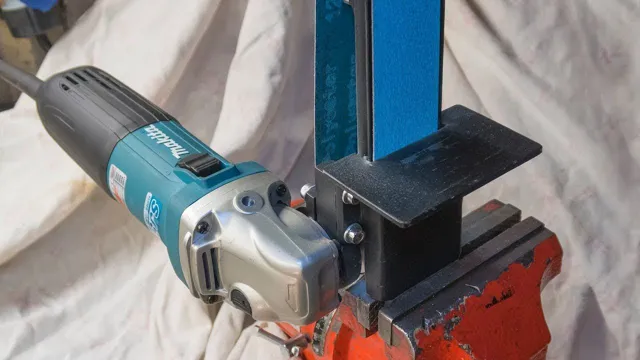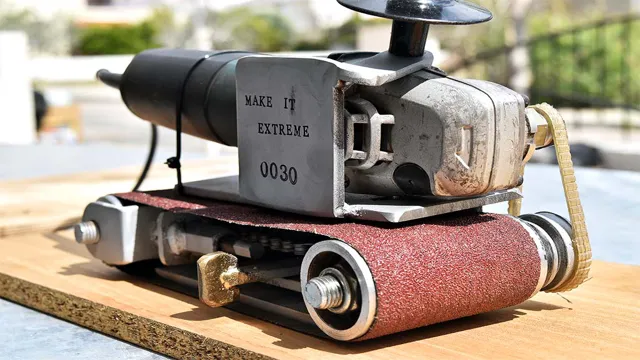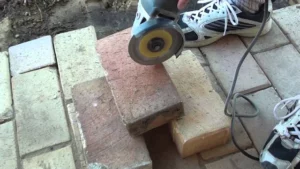If you’re a DIY enthusiast, you know the importance of having the right tools for every job. However, sometimes it’s not feasible to invest in a new tool for every project. That’s where the beauty of multi-purpose tools comes in.
Angle grinders are one of those tools that can do more than one job, and you might be wondering, “Can an angle grinder be used as a sander?” The answer is yes! Angle grinders are incredibly versatile tools that can be used for a variety of tasks, including sanding. In this blog, we’ll explain how you can use your angle grinder as a sander and provide some tips to help you get the job done right. So, let’s get started!
Understanding Angle Grinders and Sanders
If you’re someone who enjoys DIY projects, you may have wondered whether you can use an angle grinder as a sander. The answer is yes, you can! Although an angle grinder is primarily designed for grinding, polishing, and cutting, it can also be used as a sander with the right attachments. A sanding disc with a backing pad can be attached to an angle grinder and used for sanding wood, metal, and other materials.
However, it’s important to note that using an angle grinder as a sander requires some caution and care as it can be more aggressive and powerful than a typical sander. It’s essential to use the right sanding disc and grit for the material you are sanding to avoid damage. So, with the right accessories and proper handling, an angle grinder can serve as a versatile tool that can handle sanding and grinding duties around the workshop or home.
What is an Angle Grinder?
An angle grinder is a versatile tool used for cutting, grinding, sanding, and polishing. It is a handheld tool with a rapid-spinning disc that is powered by electricity or compressed air. With its powerful motor and small size, an angle grinder can be used in tight spaces, making it a popular choice for DIY enthusiasts and professionals alike.
It can also be used with a variety of attachments, including abrasive discs, wire brushes, and diamond blades, allowing it to tackle a wide range of tasks. However, it is essential to use an angle grinder with caution, as it can be dangerous if not handled properly. Always wear protective gear, including eye and ear protection, and never exceed the speed limits set by the manufacturer.
With the right care and attention, an angle grinder can be a valuable asset in any workshop or toolbox.

What is a Sander?
A sander is a tool that is used to smooth surfaces and remove materials such as paint or varnish. Sanders come in different shapes and sizes for different applications. The most common types are belt sanders, orbit sanders, and palm sanders.
A belt sander is used for large surface areas and can remove material quickly. An orbit sander is used for final touches on surfaces and can be used on wood, metal, and plastics. A palm sander is great for small surface areas and tight corners and can be used on wood, metal, and drywall.
Sanders come in handy for DIY projects and for professionals in industries such as construction and woodworking. Knowing which sander to use for each job can make a big difference in the final result.
The Difference Between Angle Grinder and Sander
Many people wonder whether an angle grinder can be used as a sander, and the answer is a bit complicated. While an angle grinder can technically sand surfaces, there are important differences between the two tools. An angle grinder is primarily used for grinding and cutting metal, while a sander is designed for sanding wood, plastic, and other materials.
Angle grinders have a high RPM and typically use abrasive discs to grind away at surfaces, whereas sanders use sandpaper sheets to smooth out surfaces. Additionally, angle grinders tend to create a lot of heat and dust, making them less than ideal for sanding tasks. If you need to sand a surface, it is best to use a dedicated sander rather than an angle grinder.
While an angle grinder can be used in a pinch, it is not the best tool for the job and may actually damage the surface you are trying to sand.
Power Output
When it comes to power tools, angle grinders and sanders are two of the most commonly used tools. While they may seem similar at first glance, they are actually quite different in terms of their power output. Angle grinders are designed for heavy-duty tasks that require a lot of power and high speeds.
They are perfect for cutting metal, grinding down welds, and concrete, and removing rust and paint. In contrast, sanders are designed for lighter tasks and have less power. They are mainly used for sanding and smoothing surfaces like wood, plastic, and metal.
While there may be some crossover in the tasks that these tools can perform, it is important to use the right tool for the job to ensure the best results. So, whether you are looking to cut, grind, or sand, always consider the power output of your tool before you get started.
Speed and RPM
When it comes to tools for grinding and sanding, angle grinders and sanders might seem similar but they have distinct differences. One key difference is their speed and RPM (revolutions per minute). Angle grinders typically have higher RPM than sanders, ranging from 5,000 to 11,000 RPM, while sanders have a lower range from 4,000 to 9,000 RPM.
This means that angle grinders are designed for aggressive grinding and cutting applications, while sanders are designed for finer, smoother sanding tasks. Additionally, angle grinders use abrasive discs, while sanders use sandpaper discs or pads. With all this in mind, it’s important to choose the right tool for the job to ensure safety and achieve the desired results.
Disc or Pad Size
When it comes to angle grinders and sanders, one of the key differences lies in their disc or pad size. Angle grinders typically have larger discs, ranging from 4 to 9 inches, while sanders have smaller pads, ranging from 4 to 7 inches. This size difference affects the tool’s ability to remove material quickly and efficiently.
Angle grinders are versatile and can be used for grinding, cutting, and polishing hard materials like metal and concrete. Sanders, on the other hand, are designed for smoothing and finishing materials like wood and paint. The smaller pad size allows for more precision and control when sanding.
It’s important to choose the right tool for the job to ensure the best results and avoid accidents. So, when deciding between an angle grinder and sander, consider the task at hand and the size of the disc or pad needed for optimal performance.
Using an Angle Grinder as a Sander
Can an angle grinder be used as a sander? The answer is yes! Angle grinders can be used for a multitude of tasks including sanding surfaces. The versatile tool can be fitted with a sanding disc to remove paint, rust or other materials from a surface. It can also be used for smoothing out rough surfaces or cleaning and finishing edges.
However, it’s important to note that a proper sanding disc needs to be used to prevent damaging the surface. Additionally, the speed of the angle grinder needs to be adjusted to ensure that the sanding process is done at the appropriate pace. With some practice and the right technique, using an angle grinder as a sander can be a time-saving and efficient solution for your sanding needs.
The Right Accessories
Angle Grinders Do you need to sand a large area but don’t want to spend money on a separate sander? Fear not, as your angle grinder can double as a sander with the right accessories! All you need is a sanding disc attachment and some sandpaper discs. Be sure to choose an appropriate grit for your project and always make sure the sandpaper is securely attached to the disc. When using your angle grinder as a sander, it’s important to keep a light touch and move the tool in a circular motion to prevent gouging or uneven sanding.
With the added benefit of being able to quickly switch between grinding and sanding, an angle grinder is a versatile tool to have in your workshop. Just be sure to follow all safety precautions and wear appropriate protective gear.
Safety Precautions
Safety Precautions When using an angle grinder as a sander, it’s essential to follow safety precautions to avoid accidents. First, check that the tool is in good condition and the grinding wheel is tightly secured. Always wear personal protective equipment, including safety glasses, gloves, and a dust mask, as the process produces a lot of dust and sparks.
Before starting the work, make sure the workspace is clear and free of anything that could be entangled in the spinning wheel. Also, position the grinder securely to prevent it from moving or turning over during use. Finally, be mindful of the power cord – keep it away from the rotating wheel to avoid accidents and ensure it’s not damaged or frayed.
By taking these few simple precautions, you can minimize the risk of injury and confidently complete your sanding tasks with an angle grinder.
Conclusion
In conclusion, while an angle grinder can technically be used as a sander, it’s not necessarily the best or safest option. Just as you wouldn’t use a hammer to screw in a nail, it’s important to use the right tool for the job. So unless you’re in a pinch and have no other option, it’s probably best to invest in a dedicated sander for all your sanding needs.
Remember, safety first and always read the instructions before using any power tool!”
FAQs
What is an angle grinder typically used for?
An angle grinder is often used for cutting, grinding, and polishing metal and other materials.
Can an angle grinder be used as a sander?
Yes, an angle grinder can be used as a sander by attaching a sanding disc to the grinder. However, it may not be the most efficient or precise way to sand a surface.
What type of sanding disc should be used on an angle grinder when using it as a sander?
It is recommended to use a flap disc or sanding pad specifically designed for angle grinders when using it as a sander.
Is it safe to use an angle grinder as a sander?
It can be safe to use an angle grinder as a sander if proper safety precautions are taken, such as using the appropriate disc, wearing protective gear, and following safe operating procedures.
Can an angle grinder be used for wet sanding?
It is not recommended to use an angle grinder for wet sanding as it can cause damage to the grinder and potentially create a safety hazard.
What are the benefits of using an angle grinder as a sander?
Using an angle grinder as a sander can provide versatility and save space in a workshop by combining two tools into one.
What are the disadvantages of using an angle grinder as a sander?
The main disadvantage of using an angle grinder as a sander is that it may not provide the precision and control needed for certain sanding tasks, such as working on small or delicate surfaces.







